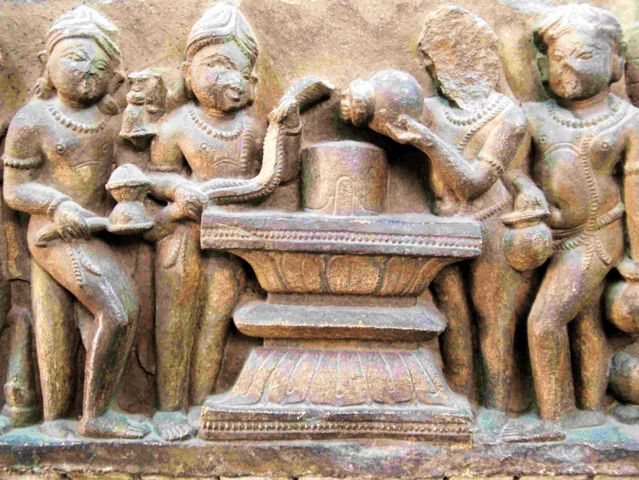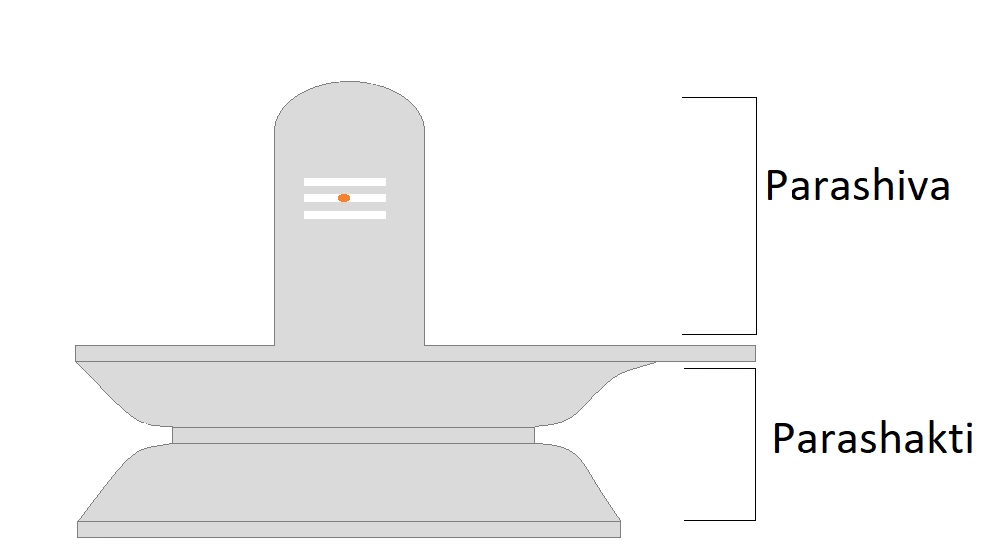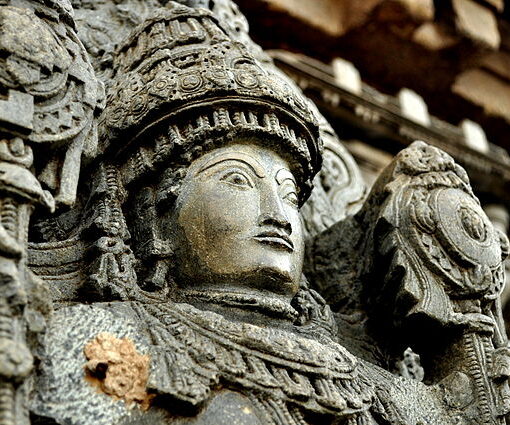The Shiva Lingam (or Linga), is an aniconic representation of Lord Shiva and is one of the most significant and widely worshipped sacred symbols of the Hindu religion. It is a cylindrical or oval shaped stone and it is often placed on a pedestal or platform called the yoni. The lingam together with the yoni symbolize the union of Shiva and Shakti, the divine masculine and feminine energies that create and sustain the universe. The word linga or lingam is derived from Sanskrit, meaning sign or symbol, so, in essence, Shiva Lingam means the symbol or emblem of Shiva.
The Shiva Lingam is a conceptualization of the merging of the supreme unmanifested femine energy of the cosmos (Prakriti) and the pure consciousness of the masculine energy (Purusha). As such, it can be said that it the Shiva Lingam is representative of God’s power. The worship of the lingam as a symbol of cosmic creativity and fertility, is an ancient practice and is associated with many traditions and rituals. The traditional ritual includes libation of milk, water and honey as well as offerings, such as flowers. Prayers and mantras are also chanted in devotion to Lord Shiva. Lingams can be found in temples dedicated to Shiva, in private shrines, but also in special pilgrimage sites where they have formed naturally.
Featured Image: Bernard Gagnon, Nandi and a linga, Maheshwar, CC BY-SA 3.0
You may also like:
Lord Shiva: The Powerful Destroyer of the World
Shiva Nataraja: Lord of the Dance & Master of Time
The Most Important & Celebrated Avatars of Lord Shiva
Table of Contents
- Historical Background of the Shiva Lingam
- The Origin of the Shiva Lingam
- Symbolism & Significance of the Shiva Lingam
- Types of Shiva Lingam
- The 12 Jyotirlinga (Lingams of Radiance)
- The 5 Pancha Bhuta Lingams
- Other Famous Shiva Lingams
- Controversies Surrounding the Shiva Lingam
- Conclusion & Final Thoughts
Historical Background of the Shiva Lingam

The earliest records to the Shiva Lingam date back to around 2500 BCE in the Harappan civilization where archaeological findings revealed the worship of a phallic-shaped stone, a possible precursor to the Shiva Lingam.
The form of the Shiva Lingam has also evolved over time. From a simple, roughly hewn and unadorned stone to more elaborate forms, decorated with intricate carvings and engravings.
The Origin of the Shiva Lingam
In the Hindu mythology, the Shiva Lingam is believed to have emerged from the cosmic egg, which represents the creation of the universe. It is the formless and timeless representation of Lord Shiva, who is the ultimate reality, and the destroyer of all that is negative and impure.
The Pillar of Fire
The Shiva Purana describes the Shiva Lingam as a cosmic pillar (the great Stambha or Skambha) of fire, that has no beginning and no end, and is the cause of all causes. The story goes that once, Brahma and Vishnu had an argument about who was the superior deity among them and who should be worshipped first. All of a sudden, they heard a voice and an infinite pillar of fire appeared before them. The voice challenged them to find the Aadi (beginning) and the Antha (end) of that flaming linga. Whoever could succeed in finding it would be deemed the greatest.
Lord Vishnu, who took the form of a boar (Varaha), headed towards the bottom of the pillar while Brahma, in the form of a swan, ascended to its top. Upon returning, Vishnu conceded his defeat, having been unable to locate the end. Conversely, Brahma lied and claimed that he had found the top of the pillar.
According to the myth, on his way to the top, Brahma saw a Ketaki flower falling from above and when he asked where it came from, the flower replied from the top. Hence, Brahma decided to use this as evidence to declare that he had reached the top. However, Shiva, who saw what happened, cursed Brahma for his lie not be worshipped by humans ever again.
In another variation of the story, Vishnu and Brahma were unable to find the beginning or end of the pillar so they bowed down to it, wondering what it was. Suddenly, the pillar burst open, and Lord Shiva appeared from within, revealing himself as the supreme god, Mahadeva, of the universe.
Symbolism & Significance of the Shiva Lingam
The Shiva Lingam is a complex symbol with multiple layers of meaning. At its most basic level, it represents the phallus or male reproductive organ, which symbolizes the creative energy of Lord Shiva. The phallic symbolism is meant to convey the idea that all creation comes from the union of the masculine and feminine energies.
The Lingam represents the formless aspect of Shiva, which is beyond human comprehension. After all Shiva means “that which is not”, a meaning of Shiva that defies conceptualization. The Shiva Lingam is a subtle representation of the divine consciousness that pervades the entire universe. The oval-shaped stone is the symbol of the Universe, and the bottom base represents the Supreme Power that holds the entire Universe in it.
Shiva Lingam and Yoni
Linga means a male sexual organ, and the base of it, the Yoni, means a female reproductive organ. However, the symbolism of the Shiva Lingam goes beyond just the phallus or the representation of the act of copulation. It is a symbolic representation of the formless and timeless aspect of Shiva. It is the ultimate reality that transcends the physical world.
The Shiva Lingam as a Representation of Shiva and Shakti
The Shiva Lingam represents an attempt to give form to the formless. When installed on a Yoni, it represents the beginning of creation: the union of Shiva and Shakti. There is no Shakti without Shiva and no Shiva without Shakti, because formless Shiva gets manifested through the base of Shakti.
In his highest aspect (Parashiva), Shiva is the absolute reality, beyond time, space and form. In Parashakti perfection (the highest aspect of Shakti), Shiva is the all-pervasive, pure consiousness, the primal substance of all that exists and it has form, unlike Parashiva which is formless.
The Shiva Lingam as the Representation of the Infinite
The Shiva Lingam is an aniconic representation of the indivisible oneness of Prakriti and Purusha, with Prakriti being the unmanifested, supreme feminine energy and Purusha the masculine conscious energy.
According to the Linga Purana, Brahma resides at the root, Vishnu in the middle and Shiva at the top of the Shiva Lingam. Therefore, all creation and all gods finally merge in the Lingam.
In addition, the Shiva Lingam is also a symbol of the cosmic pillar, which is the axis around which the universe revolves. It is said to be the point where heaven and earth meet, and it represents the connection between the material world and the spiritual world.
Types of Shiva Lingam
The Shiva Lingam is made of different materials such as stone, metal, crystal, wood, and even precious stones. Each material has its own unique properties, and the Shiva Lingam made of that material is believed to possess those properties. Depending on the material, it is believed that the Shiva Lingam influences a corresponding chakra of the human body.
Consecration of the lingam is very important, so it is imperative, while constructing it, to recite the “Om Namah Sivaya” mantra in order to make it sacred and holy.
Shiva lingams are often found by chance in the beds of sacred rivers such as the Narmada. Many researchers and geologists believe that the Narmada Shiva Lingams, a type of crystalline rock found in the Narmada River in India, were formed 14 million years ago when a meteorite crashed into the river. This event fused the earthly minerals with the meteorite, resulting in a new type of rock with exceptional energetic properties.
The 12 Jyotirlinga (Lingams of Radiance)
There are several famous Shiva Lingams located in different parts of India, however, the most auspicious and holy ones are the 12 Jyotirlingam which are mentioned in the Shiva Purana. These lingams which are a representation of Shiva’s infinite nature, are believed to have been established by Lord Shiva himself:
Kashi Vishwanath, Varanasi
Located in the holy city of Varanasi, this temple is believed to be the holiest of the 12 Jyotirlingas and attracts millions of devotees every year.
Somnath Temple, Gujarat
This is one of the oldest and most sacred Shiva temples in India, with a rich history dating back to ancient times.
Mallikajurna Temple, Andhra Pradesh
The Mallikajurna Temple is renowned for its intricate architecture and rich history.
Mahakaleshwar Temple, Madhya Pradesh
Situated on the banks of the Shipra River, this is one of the most revered and visited Shiva temples.
Omkareshwar Temple, Madhya Pradesh
Located on an island in the Narmada River, the Omkareshwar temple is known for its unique architecture.
Kedarnath Temple, Uttarakhand
Located in the Himalayas, this temple is one of the four sites of the Char Dham Yatra (a pilgrimage circuit of four holy sites), and is believed to be one of the most important Shiva temples in India.
Bhimashankar Temple, Maharashtra
This temple is surrounded by lush green forests and is known for its stunning natural beauty.
Triambakeshwar Temple, Maharashtra
The Triambakeshwar Temple is located in the Nashik district and is famous for its ancient architecture and scenic surroundings.
Vaidyanath Temple, Jharkhand
Located in the small town of Deoghar, this is believed to be one of the most powerful Shiva temples in India.
Rameshwaram Temple, Tamil Nadu
This temple is located on an island in the Gulf of Mannar and is known for its ancient history and beautiful architecture.
Grishneshwar Temple, Maharashtra
The Grishneshwar Temple is located near the scenic Ellora Caves and is known for its unique architecture and rich history.
Nageshwar Temple, Gujarat
Situated near the scenic Dwarka Beach, the Nageshwar temple is renowned for its beautiful architecture and serene surroundings.
The 5 Pancha Bhuta Lingams
According to the Vedas the material world is made of a combination of five (pancha) bhutas (elements): earth, fire, water, air and ether (space). The Pancha Bhuta Lingams, each of which is made of one of the five elements, are located at the following temples:
Ekambareswarar Temple in Kanchipuram: Bhumi Lingam (Earth element)
Arunachaleswara Temple in Thiruvannamalai: Agni Lingam (Fire element)
Jambukeshwarar Temple in Thiruvanaikaval: Varuna Lingam (Water element)
Kalahasthi Temple in Kalahasthi: Vayu Lingam (Air element)
Thillai Natarajar Temple in Chidambaram: Indra Lingam (Ether element)
Other Famous Shiva Lingams
According to Hindu tradition, places where natural lingams are found in the form of cylindrical rocks or ice or rocky hill, are holy sites of pilgrimage. One of them is the Shivling, a Shiva Lingam shaped mountain of 6543m height in the Western Garhwal region of the Himalayas. In addition, inside a cave in Amarnath, in the northern state of Jammu, an ice lingam is formed naturally by the stalagmite that drips from the roof of the cave.
Finally, one of the oldest Shiva Lingams is said to be the Gudimallam Lingam, a phallic shaped object with an image of Shiva, which dates back to the 3rd century. This Lingam is believed to have been carved out of a single rock and is considered to be a particularly powerful manifestation of Lord Shiva.
Controversies Surrounding the Shiva Lingam
Although it is one of the most sacred items of Hinduism, the Shiva Lingam has been the subject of controversy and criticism. The most common is the misinterpretation of its phallic symbolism which some misinterpret as symbolic of sexual desire. However, the phallic symbolism is not meant to convey any sexual connotations, but is a representation of the creative energy of Lord Shiva, which is the source of all creation.
According to the spiritual teacher Sivananda Saraswati (or Swami Sivananda), the correlation of the linga and male organ of god Shiva is wrong; the Lingam is only the external symbol of Lord Shiva’s formless being.
Additionally, another criticism has to do with the certain forms of worship and rituals, such as animal sacrifices that are viewed as cruel and inhumane. However, such practices are neither a part of mainstream Hinduism, nor are they condoned by the vast majority of Hindus.
The Shiva Lingam is an aniconic symbol and a conceptualization of the cosmic mysteries and the creative powers of the universe. In the words of the great spiritual teacher Swami Vivekananda, the Shiva Lingam is the representation of the eternal Brahman.
Conclusion & Final Thoughts
While there may be controversies and criticisms surrounding the Shiva Lingam, it is important to understand its true symbolism and respect its cultural and religious significance.
The Shiva Lingam is a powerful symbol of the cosmic masculine and feminine creative energies. As such, it serves as a reminder of the divine presence within all living beings and the oneness of all things. The worship of the Shiva Lingam, apart from a sign of devotion to Lord Shiva, is also a powerful practice for spiritual transformation and inner growth.
For those interested in incorporating the worship of Shiva Lingam into their spiritual practice, there are several ways to do so. The simplest way is to obtain a small Shiva Lingam and place it on an altar or sacred space in the home. Devotees can perform daily rituals and offer prayers to the Shiva Lingam, or simply sit in meditation in its presence.
- Ardhanarishvara: The Powerful Synthesis of the Two Opposites in One

- Hanuman: The Most Valuable Life Lessons from the Monkey God

- King Kakudmi: One of the Most Amazing Hindu Myths

- Kakbhushundi: One of the Most Fascinating Tales from Hindu Mythology

- Ashtavakra Gita: One of the Greatest Masterpieces of Hindu Philosophy

- Mudgala Purana: Unveiling the Most Popular Ganesha Avatars







